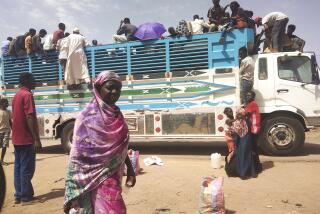Former Slaves Taste Freedom in Sudan
- Share via
MARIAL BAI, Sudan — Awut, 4, gives her total concentration to drinking a bottle of cola, draining it with gulp after gulp, stopping only for the occasional gasp of air.
When it is empty, she looks down its neck with one eye just to make sure. A frown flickers across her brow and she sinks back in her mother’s lap.
Few children in southern Sudan have ever tasted a soft drink, but Awut’s short life has been even more austere than most. As a baby, she was among thousands of Sudanese from the southern Dinka tribe abducted in raids on their villages by Arab militiamen and taken to the north to be sold as slaves.
The centuries-old practice of slave trading in Sudan, which straddles the Arab and African worlds, was brought to an end by British colonial rule in the early 20th century. But rather than being confined to the history books, raids and abductions have been revived by a civil war between the Islamic government and rebels in the mainly Christian and animist south.
*
Since the conflict resumed in 1983, the rebels say, the government has aided and abetted the militia in raiding southern villages --usually on horseback--to loot, burn and leave with cattle and slaves.
Awut’s mother Anuat Dhum was carrying her baby in her arms and trying to run from the raiders when they were captured.
“When they caught us, they made us run with them,” she said. “I couldn’t keep up but if I stopped to rest, they beat me. They used the butts of their rifles until I got up again.”
Anuat and Awut spent three years in captivity before they found themselves among a small minority of slaves who were rescued. Now home is a thatched-roofed round hut or “tukul” in the rebel-held town of Marial Bai, where nothing more exciting than soap, salt and fishing nets is on sale in the market.
To an outsider, the hot, dusty town seems like the end of the Earth, surrounded by nothing but miles of flat and unforgiving scrub. But to Anuat, dressed in a ragged floral dress with a string of plastic yellow beads around her neck, Marial Bai is a haven from the horrors of the last three years.
“I was completely a slave, more than a slave,” she said, encouraged by aid workers to speak about her captivity with the promise of a rare soda. “I was continuously beaten because whenever I would stop to feed my baby with my breast milk, somebody would get angry and say I wasn’t working.”
When Anuat was sent to tend cattle, her baby was locked up indoors with no one to hear her cries. Anuat, repeatedly raped, had little hope she would ever be free and still understands little about her release.
“There was a group of Arabs and white men who came to visit all the villages,” she said. “They asked us who we were, where we were from and then they took us away in trucks.”
Anuat and Awut are among 177 slaves who have been returned to their homes through a program started by the government last year.
Bowing to international pressure, it set up a committee to work with Dinka chiefs now living in the north to identify slaves, retrieve them from their captors and send them home.
The freed slaves were flown to the southern government-held town of Aweil and allowed to run across the front line into areas held by the rebel Sudan People’s Liberation Army. From there, the women and children walked, sometimes for days, to their homes and families.
The numbers returned in this way are small compared to the thousands of slaves “redeemed” by groups such as Swiss-based Christian Solidarity International, which raises funds to buy back slaves.
But despite the apparent irony of working with the Sudan government, some human-rights workers believe its program is the only sustainable way to end the practice.
“We don’t believe that paying for people is the right way forward,” said Martin Dawes, south Sudan spokesman for the U.N. children’s agency UNICEF, which is supporting the project. “We’re trying to do something much longer term, to change the culture on a much more fundamental level and to bolster the government’s capacity to deal with the problem.”
*
An upsurge this fall in fighting around Aweil has meant that no reunifications have taken place across the front lines since August, and the United Nations has just reported another raid near Marial Bai.
No one knows how many women and children were abducted this time, but the raid has certainly left more families keeping a vigil for their loved ones.
“The time my daughter was taken, so many people were killed,” said Dinka elder Desiderio Dau Chol, whose daughter was snatched more than two years ago.
“I thought she might be dead so I looked everywhere, at all the bodies, to see if I could recognize her clothes. She was not among them, but still she has not come back.”
More to Read
Sign up for Essential California
The most important California stories and recommendations in your inbox every morning.
You may occasionally receive promotional content from the Los Angeles Times.









